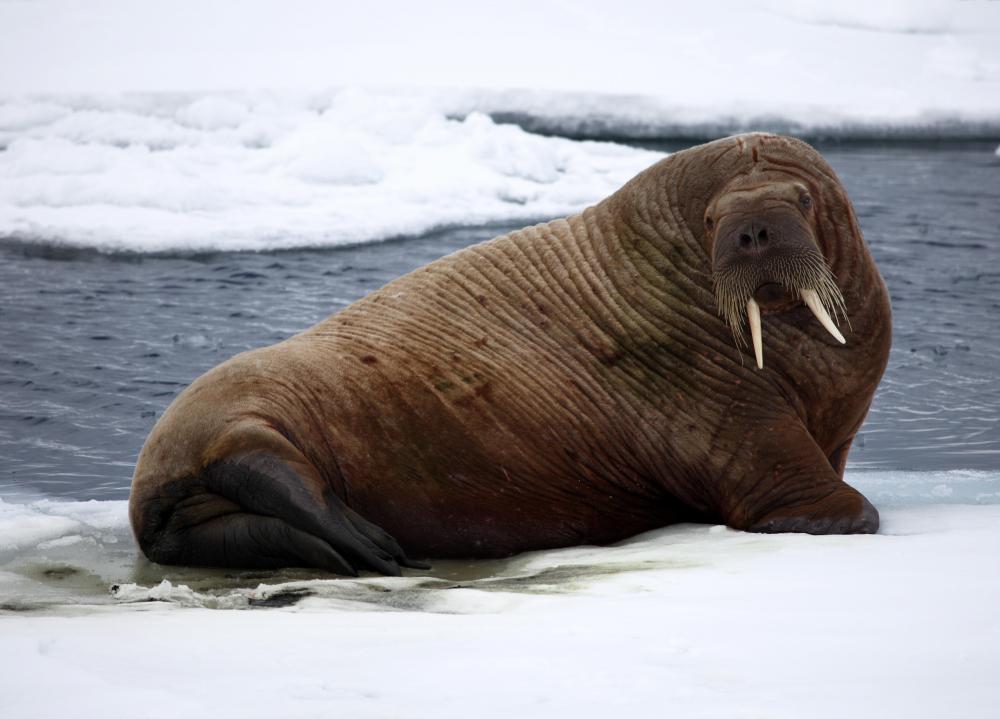At AllThingsNature, we're committed to delivering accurate, trustworthy information. Our expert-authored content is rigorously fact-checked and sourced from credible authorities. Discover how we uphold the highest standards in providing you with reliable knowledge.
What Is a Tusk?
A tusk is a kind of tooth that extends past the confines of an animal’s mouth. Tusks often keep growing throughout a creature's life, and they may be constantly worn down by use. Many different kinds of animals have tusks, including elephants, certain kinds of wild pigs, and walruses. They serve different purposes in different species, and often have several uses, including self-defense or as a tool. People use tusks to make ivory, which can have a lot of utility for people, but the use of ivory has put a lot of strain on the population of the elephant.
One of the main uses for a tusk in animals is fighting. Sometimes they use them to fight off predators that might be attacking, or they might simply be used to fight off other animals in their social group, especially in relation to mating. For example, two male elephants will occasionally lock tusks in much the same way deer will fight with their antlers, and sometimes elephants can be severely wounded in these fights. When it comes to using tusks for self defense against predators, one of the more commonly-used examples are various species of wild hog, which have been known to wound other animals badly with their tusks. Two other fairly common uses for tusks are as a tool for digging and as a physical display for sexual purposes.

A tusk is actually a tooth that is drastically oversized. The teeth that eventually grow into tusks can vary a lot in different species. Canines and incisors are the most common teeth to eventually become tusks, and between the two, the canines are generally more common. Walruses, for example, have tusks that are actually canines, while elephants have tusks that are actually incisors. The tusks themselves never stop growing in most cases, so that even if the animal uses them until they start to wear down, it will generally grow it all back.

The tusk of an animal is used to make the substance known as ivory. Over the years, ivory has been used for many different things, including ornaments, piano keys, and jewelry. Primarily, people have taken ivory from elephants, although ivory can also come from many other tusked animals. The buying and selling of ivory has generally put the elephant population under threat of extinction and reduced their numbers massively in many different areas. Laws have been passed in many areas to protect the elephant with mixed levels of success.
Frequently Asked Questions
What exactly is a tusk, and how does it differ from a tooth?
A tusk is a specialized type of tooth with an elongated shape that protrudes beyond the mouth of certain animals, such as elephants, walruses, and narwhals. Unlike regular teeth, tusks often serve purposes beyond eating, such as for defense, digging, or mating displays. They are typically larger and more robust than other teeth.
Which animals have tusks, and what are their tusks used for?
Animals with tusks include elephants, walruses, narwhals, and warthogs. Elephant tusks are used for digging, foraging, and as a display of dominance. Walrus tusks aid in hauling themselves onto ice and in social interactions. Narwhal tusks are thought to play a role in sensing environmental changes, while warthogs use theirs for digging and defense.
Are tusks made of the same material as human teeth?
Yes, tusks are composed of the same materials as human teeth: dentin, enamel, cementum, and pulp. The primary material is dentin, which is covered in a layer of enamel—the hardest substance in the body. Over time, the enamel can wear down, exposing the dentin, as seen in well-used tusks.
How do tusks grow, and do they ever stop growing?
Tusks grow continuously throughout an animal's life, much like human fingernails. They emerge from the skull and are rooted deep in the animal's head. Growth rates can vary, but for example, elephant tusks grow at about 7 inches per year, according to the World Wildlife Fund. Tusks do not stop growing, but their length can be limited by wear and breakage.
Why are tusks so valuable, and what impact does this have on wildlife?
Tusks, particularly elephant ivory, are highly valued for their beauty and rarity, often used in art, jewelry, and ornaments. This demand has led to severe poaching, threatening species with extinction. Conservation efforts are critical, as the African elephant population has seen a significant decline, with only about 415,000 remaining, as reported by the International Union for Conservation of Nature.
What conservation efforts are in place to protect tusked animals from poaching?
Conservation efforts include international trade bans on ivory, such as the CITES agreement, anti-poaching patrols, and the establishment of wildlife reserves. Organizations also work on community-based conservation, which involves educating local populations and providing alternative livelihoods to reduce poaching incentives. Technology, like drones and GPS tracking, is increasingly used to monitor and protect these animals.
AS FEATURED ON:
AS FEATURED ON:












Discuss this Article
Post your comments